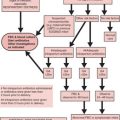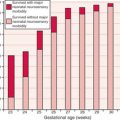CHAPTER 14 Care of the extremely preterm baby
Initial care of the ELBW infant prior to transfer to Level 3 nursery
Resuscitation
• Intubate or not? This depends on the paediatrician’s comfort zone — the default option is intubate and ventilate.
Intubation/Ventilation
• This depends on the paediatrician’s comfort zone — safest to intubate and ventilate unless baby looks very good.
• If on CPAP (continuous positive airway pressure), start with 7–8 cmH2O; unless in air, then use 5 or 6 cmH2O.
• Surfactant: unless in air on lowish pressures, give surfactant (Survanta 4 mL/kg; Curosurf 2.5 mL/kg).
Blood pressure
• MABP in mmHg > GA in weeks is OK — if well perfused. (MABP = mean arterial blood pressure; GA = gestational age.)
• Low BP: 10 mL/kg Nsaline (some use albumin) ×2, then dopamine 3–5 μg/kg/min (see page 82). Timing of second Nsaline/albumin dose depends on response to first. (Nsaline = Normal saline, 0.9%.)
Lines
• Consultants only — put in an umbilical venous catheter (UVC) and maybe an umbilical arterial catheter (UAC). Never use the second umbilical artery if unsuccessful with the first — leave that for the staff at the Level 3 neonatal unit. An ELBW infant without adequate umbilical lines can be a major problem.
• Measure tip of right shoulder to umbilicus — put UAC in this distance, or use the ‘ready reckoner’ tables on pages 166–8.
• Measure bottom end of sternum to umbilicus — put UVC in this far, or use the ‘ready reckoner’ tables on pages 166–8. UVC tip should be at the bottom of the heart between T8 and T9; if below T9 but good blood flowback when aspirated, then leave in place and use for 10% dextrose and urgent drugs.
Guidelines for care of infants <1000 g / <28 weeks at a Level 3 nursery
1. Consultant or ‘attending’ neonatologist (and at least one registrar/fellow/resident/neonatal nurse practitioner) to be present at delivery.
2. Where indicated, intubate with a size 2.5 endotracheal tube (ETT) to:
Use a Neopuff or similar T-piece device (see page 8) to deliver PEEP and ventilate to transfer to nursery.
If not needing intubation, commence CPAP from delivery (Neopuff).
6. Surfactant — give early rather than late:
7. Insert:
— umbilical arterial catheter (UAC), 3.5FG — consultant or ‘attending’ neonatologist or a senior trainee should do this; little babies are not for learners.
Use great care in swabbing the abdomen.
• Alcoholic chlorhexidine burns — apply very sparingly, with only a corner of the swab wet. Never allow any to run down the side of the abdomen.
9. If platelet count is >50 × 109/L then give prophylactic indomethacin IV 0.1 mg/kg daily for 3 days — start <12 hours (i.e. 0.08 mg if 800 g etc — be careful writing up the dose).
10. Chest/abdominal X-ray after ETT and umbilical lines; repeat the next day to recheck UVC position — sometimes they migrate (in). Repeat X-ray daily until UVC tip is in a stable position.
11. Clean neck with triclosan swab, then dry; apply a transparent, bio-occlusive, polyurethane dressing (such as Bioclusive, Tegaderm, Opsite); commence topical and enteral nystatin.
12. Monitor serum electrolytes with blood gases. Laboratory specimen for albumin, phosphate twice a week only.
13. Full blood count and film examination (FBC) on days 1, 3, 5 and 7; then twice weekly for 2 weeks; then weekly (with reticulocytes).
14. Cranial ultrasound on days 3, 10 and 42 is recommended as routine. Other units have different regimens; however, it is important to do early scan/s to detect intraventricular haemorrhage and a late scan (≥4 weeks) to detect cystic periventricular leucomalacia.
15. Commence parenteral nutrition on day 3 (via a correctly positioned UVC) if electrolytes stable (especially [K+] <5 mmol/L).
16. Insert a silastic central venous line (CVL) on day 3–7 as indicated, remove UVC then (by day 5 if possible).





